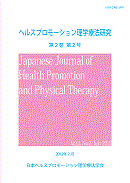Volume 6, Issue 1
Displaying 1-7 of 7 articles from this issue
- |<
- <
- 1
- >
- >|
REVIEW
-
2016Volume 6Issue 1 Pages 1-7
Published: April 30, 2016
Released on J-STAGE: July 29, 2016
Download PDF (489K)
ORIGINAL ARTICLES
-
2016Volume 6Issue 1 Pages 9-15
Published: April 30, 2016
Released on J-STAGE: July 29, 2016
Download PDF (476K) -
2016Volume 6Issue 1 Pages 17-22
Published: April 30, 2016
Released on J-STAGE: July 29, 2016
Download PDF (379K) -
2016Volume 6Issue 1 Pages 23-28
Published: April 30, 2016
Released on J-STAGE: July 29, 2016
Download PDF (434K) -
2016Volume 6Issue 1 Pages 29-33
Published: April 30, 2016
Released on J-STAGE: July 29, 2016
Download PDF (519K)
SHORT REPORT
-
2016Volume 6Issue 1 Pages 35-39
Published: April 30, 2016
Released on J-STAGE: July 29, 2016
Download PDF (478K)
FIELD REPORT
-
2016Volume 6Issue 1 Pages 41-44
Published: April 30, 2016
Released on J-STAGE: July 29, 2016
Download PDF (327K)
- |<
- <
- 1
- >
- >|
